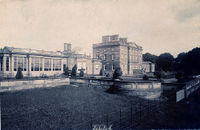Annotation:Ladykirk House: Difference between revisions
(Created page with "'''Back to [[{{BASEPAGENAME}}]]''' ---- <p><font face="garamond, serif" size="4"> '''LADYKIRK HOUSE.''' Scottish, Jig (9/8 time). A Major. Standard tuning (fiddle). AAB. Compo...") |
m (Text replacement - "garamond, serif" to "sans-serif") |
||
| (One intermediate revision by one other user not shown) | |||
| Line 1: | Line 1: | ||
'''Back to [[{{BASEPAGENAME}}]]''' | '''Back to [[{{BASEPAGENAME}}]]''' | ||
---- | ---- | ||
<p><font face=" | <p><font face="sans-serif" size="4"> | ||
'''LADYKIRK HOUSE.''' Scottish, Jig (9/8 time). A Major. Standard tuning (fiddle). AAB. Composed by Nathaniel Gow (1763-1831). Ladykirk House, Monkton, Berwickshire, was a manor built in 1797 on the northern (Scottish) side of the River Tweed, across from Norham, England. The area was a favorite fording-place for warring armies back and forth. It was originally called Upsettlington until James IV nearly drowned trying to cross the Tweed, and, in thanks for his delivery, built a church near the spot (thus changing the name to Ladykirk). The manor was demolished in 1966. | '''LADYKIRK HOUSE.''' Scottish, Jig (9/8 time). A Major. Standard tuning (fiddle). AAB. Composed by Nathaniel Gow (1763-1831). Ladykirk House, Monkton, Berwickshire, was a manor built in 1797 on the northern (Scottish) side of the River Tweed, across from Norham, England. The area was a favorite fording-place for warring armies back and forth. It was originally called Upsettlington until James IV nearly drowned trying to cross the Tweed, and, in thanks for his delivery, built a church near the spot (thus changing the name to Ladykirk). The manor was demolished in 1966. | ||
[[File:ladykirk.jpg|200px|thumb|left|Ladykirk House]] | |||
<br> | <br> | ||
<br> | <br> | ||
</font></p> | </font></p> | ||
<p><font face=" | <p><font face="sans-serif" size="4"> | ||
''Source for notated version'': | ''Source for notated version'': | ||
<br> | <br> | ||
<br> | <br> | ||
</font></p> | </font></p> | ||
<p><font face=" | <p><font face="sans-serif" size="4"> | ||
''Printed sources'': Carlin ('''The Gow Collection'''), 1986; No. 343. Gow ('''Fifth Collection of Strathspey Reels'''), 1809; p. 22. | ''Printed sources'': Carlin ('''The Gow Collection'''), 1986; No. 343. Gow ('''Fifth Collection of Strathspey Reels'''), 1809; p. 22. | ||
<br> | <br> | ||
<br> | <br> | ||
</font></p> | </font></p> | ||
<p><font face=" | <p><font face="sans-serif" size="4"> | ||
''Recorded sources'': <font color=teal></font> | ''Recorded sources'': <font color=teal></font> | ||
</font></p> | </font></p> | ||
Latest revision as of 14:11, 6 May 2019
Back to Ladykirk House
LADYKIRK HOUSE. Scottish, Jig (9/8 time). A Major. Standard tuning (fiddle). AAB. Composed by Nathaniel Gow (1763-1831). Ladykirk House, Monkton, Berwickshire, was a manor built in 1797 on the northern (Scottish) side of the River Tweed, across from Norham, England. The area was a favorite fording-place for warring armies back and forth. It was originally called Upsettlington until James IV nearly drowned trying to cross the Tweed, and, in thanks for his delivery, built a church near the spot (thus changing the name to Ladykirk). The manor was demolished in 1966.

Source for notated version:
Printed sources: Carlin (The Gow Collection), 1986; No. 343. Gow (Fifth Collection of Strathspey Reels), 1809; p. 22.
Recorded sources:
Back to Ladykirk House
